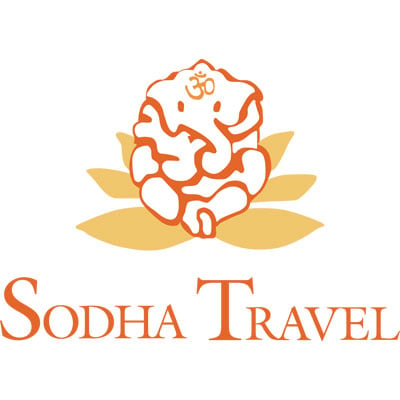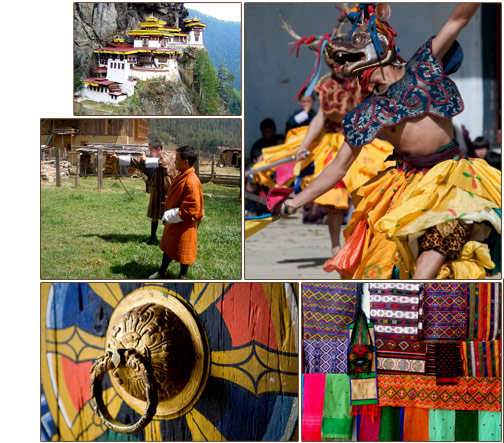Legacy of Bhutan
10 days/9 nights
Although Bhutan's early history is rich in mythology, much of it remains unknown. The country opened its doors to tourism in 1974, with the number for tourists kept to an environmentally manageable level through government regulated tourist tariffs. Bhutanese are renowned for their happiness and are a proud people who wear their national costume with pride. In this tour, visit the wondrous sights of Paro, Thimphu, Punakha, Gangtey, and Bumthang. Experience the legacy of Bhutan, a jewel in the Himalayas.
Highlights
Taktsang Monastery (Tiger's Nest)
Stunning views of the Himalayas
Phobjikha Valley, one of Bhutan's few glacial valleys
Kurje Lhakhang, considered one of the most sacred places in Bhutan
Itinerary Details: 10 days/9 nights
Day 1: Arrive Paro
On a clear day, the flight to Paro is one of the most spectacular of all mountain flights. You will see major Himalayan peaks such as Everest, Kanchenjunga and Makalu. On the final approach to Paro, view Bhutan's own snowy peaks, including Chomolhari, Jichu Drake and Tserimgang. Bhutan's first gift to you as you disembark from the aircraft will be cool, clean fresh mountain air. You will be met by your representative and taken to your hotel.
In the afternoon, drive towards the north end of the valley to view the spectacular Rinpung Dzong ("the fortress of the heap of jewels") built by Shabdrung Ngawang Namgyal in 1646. It now houses Paro's monk body and the offices of the civil administration. It is also the venue for the annual springtime Paro Tsechu (festival). Above Rinpung Dzong (commonly referred to as Paro Dzong) is Ta Dzong, housing the National Museum, which holds unique and varied collections including ancient armor, textiles, thangkha paintings, stamps, coins and natural history. In the evening, take a stroll around Paro market. Overnight in Paro.
Day 2: Paro
In the morning, take an excursion to Taktsang Monastery, also known as Tiger's Nest. It is believed that Guru Rinpoche, founding father of the Bhutanese form of Mahayana Buddhism, arrived here on the back of a tigress and meditated at this monastery. The main structure was severely damaged by fire in 1998, but after many years of painstaking restoration work, the complex has now been fully restored to its former glory. Overnight in Paro.
Day 3: Paro - Thimphu
Today drive to Thimphu, the capital of Bhutan. Upon arrival, visit the following: The National Library, with its extensive collection of priceless Buddhist manuscripts; the Institute for Zorig Chusum (commonly known as the Painting School) where students undergo a six-year training course in Bhutan's 13 traditional arts and crafts; and the National Institute of Traditional Medicine (outside only), where Bhutan's famed traditional herbal medicines are compounded and dispensed.
Later, visit the Memorial Chorten, the Traditional Paper Factory and the Takin Reserve. Overnight in Thimphu.
Day 4: Thimphu – Punakha
After lunch, proceed to Punakha across Dochu-la Pass (3,088m/10,130ft). The highest point on the road is marked by a large Bhutanese chorten and prayer flags fluttering on the hill. On a clear day, there is a breathtaking view over the high peaks of the eastern Himalayas from this spot.
Punakha served as the capital town of Bhutan until 1955, and it is still the winter seat of the Je Khenpo (Chief Abbot). Visit Punakha Dzong, built by Shabdrung Ngawang Namgyal in the 17th century and situated at the junction of Pho Chu and Mo Chu Rivers. Also visit Khamsum Yulley Chorten built for World Peace. The chorten is perched on a small hill and the walk takes about 30-45 min. Overnight in Punakha.
Day 5: Punakha –Gangtey
After breakfast, depart for Gangtey via Wangdi. You will drive up a winding mountain road through oak and rhododendron forest and over a high pass down into the Phobjikha Valley, surely one of the loveliest high altitude valleys in Bhutan. Phobjikha is one of Bhutan's few glacial valleys and chosen winter home of black-necked cranes migrating from the Tibetan plateau. There are ample opportunities to explore the valley and villages on foot. Overnight in Gangtey.
Day 6: Gangtey – Jakar/Bumthang
After breakfast, proceed to Jakar via Trongsa. The drive takes you up a winding mountain road through oak and rhododendron forests and over Pele-la Pass (3,300m/10,830ft). This pass is traditionally considered the boundary between western and central Bhutan. Further down the road, stop to visit Chendebji Chorten erected in the 18th century by a Tibetan lama to cover the remains of an evil spirit that was subdued at this spot. It is built in the Nepalese style, with painted eyes at the four cardinal points.
The landscape around Trongsa is spectacular and its impressive dzong, stretched along a ridge above a ravine, first comes into view about an hour before the winding road suddenly leads you into the town. Proceed to Bumthang, one of the most spectacular valleys in Bhutan and also the holy heartland of Buddhism. The road winds steeply up to Yutong-la Pass (3,400m/11,155ft) then runs down through dense coniferous forest to enter a wide, open, cultivated valley, known as Chumey Valley. Continue to Bumthang and overnight.
Day 7: Bumthang
After breakfast, visit the sites of Bumthang: Jambey Lhakhang, erected by the Tibetan king Songtsen Gampo in the 7th century, is one of the two oldest in Bhutan (the other being Kyichu Lhakhang in Paro); and Kurje Lhakhang, considered one of the most sacred places in the kingdom as Bhutan's patron saint Guru Rinpoche (Padmasambhava) meditated here. Overnight in Bumthang.
Day 8: Bumthang – Punakha
Enjoy the scenic views and charming villages as you return to Punakha. Afternoon and evening at leisure and overnight in Punakha.
Day 9: Punakha - Thimphu
After breakfast, drive to Thimphu. Enjoy an optional hot stone bath, historically believed to have medicinal benefits in healing joint pains, hypertension, arthritis, and stomach disorders. Afternoon at leisure and overnight in Thimphu.
Day 10: Departure
This morning, transfer to the airport in Paro for your onward flight.
Please note that some of the sights/itinerary may change due to season, weather, national holidays, and special events. We maintain the rights to alter the itinerary since tours are made in advance and unforeseen circumstances that mandate change may arise. Itinerary changes are made to improve your overall travel experience in Bhutan.
Inclusions
- Standard hotel accommodations
- Daily breakfast, lunch and dinner
- Vehicle and driver, per the itinerary
- Comprehensive touring with an English speaking guide
- Entrance fees to the monuments
- Airport transfers with assistance
- Bhutan Visa Fee
- Bhutan Government Royalty and Taxes
- Road/interstate taxes, fuel surcharges, and parking fees
Exclusions
- International Airfare
- Any items of a personal nature
- Additional meals
- Gratuities
Supplemental Information
- A visa is required to visit Bhutan. Sodha Travel will arrange for the clearance, and the final visa will then be sent to you via email (if you are flying directly to Bhutan) or handed over in India (if you have a stopover).
- To protect your travel investment, Sodha Travel strongly recommends Travel Insurance.
- Visit our FAQ page for additional information on traveling to Bhutan.
Please note: The tourism infrastructure of Bhutan continues to develop. Therefore, the accommodation and transport standards may be different than what you are accustomed to when traveling to other destinations. Hotels are standard and comfortable with basic amenities. Flights may be delayed and ground transportation may be limited, thus causing adjustments to your scheduled itinerary. To avoid disappointment, we ask you to consider these factors when traveling to Bhutan.

